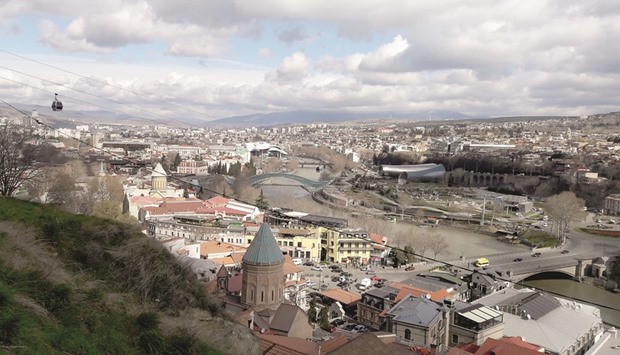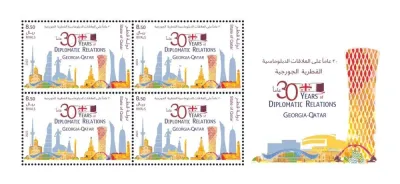There is much in the picturesque Eurasian country of Georgia for the visitors to experience and enjoy round through the year. And that too in less than a three-and-a-half hours flight from anywhere in the Gulf region — if it is a direct flight from Doha, Dubai or Sharjah to Tbilisi, Georgia’s capital city.
For the Gulf residents who have valid residence permits, no other destination is as good as Georgia as they do not require a visa to enter the country. “I hope this facility is more than enough for the Gulf residents to visit our country,” feels the head of Georgia’s National Tourism Administration George Chogovadze.
The Georgian official is sparing no efforts these days to promote tourism in his beautiful East European nation.
Recently, a 16-member group of travel professionals from Doha went on a visit to Georgia, thanks to a tie up between Flydubai airline and Georgian National Tourism.
As one of the Georgian tourism ads says: “Georgia has more to offer than any other country of its size in the world.” Certainly there is a lot to explore, from the architecture of Tbilisi’s Old Town to the vineyards of Kakheti; from the ancient stone towers of Sveneti to the vibrant beaches and lively night life of Batoumi.
Tbilisi, considered one of the best heritage and cultural destinations of the entire Eastern European region, hosts an array of educational and historically important archaeological institutions and monuments. It houses more than a third of the country’s 4.47 million population. Georgia is spread over a little over 69,000 square kilometres, a sizeable part of which is snow-clad mountains on the northern side.
The country is bounded by Turkey and the Black Sea on the western side, and the long Russian boundary lies all along the north. Armenia is in its south and Azerbaijan towards the east.
When it comes to affordability and diversity, Georgia would certainly be one of the best destinations one could consider visiting any time of the year, save for one month from the middle of December when it gets too cold. Even then, a large number of tourists from the Middle East and also Europe prefer to tour Georgia for their New Year and related celebrations.
Travel, tourist and hospitality professionals from the region and Europe rate Georgia as a destination worth visiting for a diverse experience, usually for periods ranging anywhere between four to seven days depending upon the strength of one’s purse and budget. At an interaction with a gathering of more than 100 local tour promoters of Georgia at Tbilisi’s Holiday Inn Hotel on March 15, the visitors from Qatar were briefed on a range of travel options, starting from a daily hotel tariff of $60-65 (including a standard morning breakfast).
“We have tailored an array of tour packages depending on both the budget and interests of our visitors,” said experienced Georgian tourist industry professional Elene Rakviashvilli, who has been working to promote the country among the visitors both within Georgia and outside. Rakviashvilli has more than two decades of experience. Her Tbilisi-headquartered company, Explore Georgia has been receiving tourists from virtually everywhere in the Middle East, particularly the Gulf at regular intervals.
While interacting with the team members from Doha in Old Tbilisi, which has a number of heritage sites, Chogovadze talked about the efforts that are underway to grant visa-on-arrival facility to visitors from more countries in coming months. “Already, a large number of Gulf tourists, mainly from Dubai and Oman are visiting our country,” he said while adding that Georgia is looking forward to receiving more visitors from Qatar in future.
Chogovadze said Qatar and its residents have a special place among his compatriots as it is the only Gulf country to have an embassy in Georgia. Qatar has also made investments in different spheres of the country, including agriculture and hospitality.
The tourism official said unlike many other region of Europe, Georgia has a large percentage of people who are fluent English speakers. There are also tourist professionals who have fairly good knowledge of languages such as Arabic and Persian.
Along with heritage, archaeological and historical tourism, Georgia is also actively pursuing entertainment, recreational and adventure tourism as well. The snow-clad hill station of Gudauri receives countless adventure tourists who flock to the northern destination for the more-than-three-km-long cable car ride and skiing. On one of Georgia’s land routes to Russia, the tourist haven on the high altitude hosts a number of top class resorts and hotels, equipped with spas and other fitness centres.
The tourist locations in Tbilisi, especially in its old city, are thronged by several thousand visitors daily. The Botanical Gardens in Sololaki and the more-than-1.5-km-long walkway that overlooks this part of the city are unique as they provide every visitor with a panoramic and scenic view of the Old City’s landscape.
A stroll from the Botanical Gardens through the walkway to Meidan Square, which is described by locals as the confluence of both the European and Asiatic traditions, will help one get a clearer glimpse of the old but historically more significant part of the Georgian capital. On getting there by foot, one comes across a number of souvenir stalls, and the National Art and Cultural Gallery where tourists are met by some of the locally well-known craftsmen and women and reputable designers. These give visitors a chance to get a real feel of the country’s ethnic designer wares, handicrafts and souvenirs. Though no bargaining is possible, one is certain to find quality materials at the outlets located inside the gallery.
Georgia has an elaborate spread of foods to suit the tastes of visitors from all corners of the world. While those from Asian countries favouring hot and rich curries may have some initial hiccups in settling down with some of the local delicacies, the hosts never let them down as they have plenty of options — both vegetarian and non-vegetarian. Fish seems to be in abundance as most meals seem to feature two or three varieties. Some of the starters served at every meal are similar to South Asian delicacies.
Tbilisi and surroundings have a large number of ethnic restaurants, which provide very lively atmosphere to the visitors while serving a variety of delicacies. Music from different regions of the country is played in the evenings and so many string, percussion and wind musical instrument are found at each of such concerts.
Besides leather goods and ethnic apparels, rich and colourfully embroidered clothes are sold at boutiques and on the wayside stalls splattered across Tbilisi and other parts of Georgia. There are souvenirs, mostly made of brass, Plaster of Paris and glass. The shopkeepers though — mainly women — do not seem to be interested in bargaining. That said, the general perception among visitors is that there is little control over prices and it is advisable to negotiate in the presence of a local guide.
The train connectivity between different regions of the country is fairly extensive. A large number of tourists coming from outside use train services from Tbilisi to reach Batoumi, a major beach resort that has witnessed remarkably large growth in recent times. Batoumi, the second largest city of the country and located alongside the Black Sea Coast, is also witnessing construction spree as several top-notch hotel groups are setting up their new properties there.
Frequent bus services are available across Tbilisi and taxi services seem to be adequate and fair.
Chogovadze said the low crime rate in Georgia has helped the country attract not only a large number of tourists but also students who want to pursue studies in medicine and other professional courses in Georgia’s universities. Tbilisi State University’s medical institutions alone have several hundreds of international students as the academic and boarding fees are considered lower than in many other countries. “Affordability and better track record in professional studies have [made our universities desirable],” he said.
The Tbilisi State University will complete 100 years of its existence next year.
The historically significant shrine of Sveti Tschoveli in Mtskheta is situated at the confluence of the Aragvi and Mtkvari Rivers, about 20 minutes northwest of Tbilisi. The complex has, among other attractions, the Jvari Monastery, the Sveti Tschoveli Cathedral and the Samtavro Monastery.
Mtskheta hosted the ancient headquarters of Kartli, the East Georgian Kingdom from the 3rd century BC to the 5th century AD, and was also the location where Christianity was proclaimed as the official religion of Georgia in 337. To date, it still remains the headquarters of the Georgian Orthodox and Apostolic Church.
The conducive natural conditions, its strategic location at the intersection of historic trade routes, and its close relations with the Roman Empire, the Persian Empire, Syria, Palestine, and Byzantium, generated and stimulated the development of Mtskheta and led to the integration of different cultural influences with local cultural traditions. When the capital was transferred to Tbilisi in the 6th century, Mtskheta continued to retain its leading role as one of the important cultural and spiritual centres of the country.
The Holy Cross Monastery of Jvari, Svetitskhoveli Cathedral and Samtavro Monastery are key monuments of medieval Georgia. Today’s churches include the remains of earlier buildings on the same sites, as well as the remains of ancient wall paintings. The complex of the Svetitskhoveli Cathedral includes the cathedral church, the palace and the gates of the Katolikos Melchizedek that date from the 11th century, built on the site of earlier churches dating back to the 5th century.
Kakheti
While a number of the Middle East tourists flock to Tbilisi and Gudauri, others go to Kakheti in the eastern province. The region has a long history in vineyards. Archaeological research provides evidence of viniculture in Georgia dating back to more than 7,000 years and there is a widely held belief that George was the birthplace of wine.
The travel infrastructure in the region is developing fast, as Kakheti emerges as the most frequented by tourists. Besides many boutique hotels, the place also hosts several simple but comfortable hotels. Telavi and Sighnaghi are the most visited towns of Kakheti. Until a decade ago, Sighnaghi reportedly had only a few family-run hotels. Now, the town has many professionally-managed hotels. The two towns are thronged by revellers throughout the year, including the New Year period.
No trip to Georgia will ever be complete without the spectacular sound and vision of the renowned polyphonic singing and traditional dancing, which Unesco simply describes as the “masterpiece of the world’s intangible cultural heritage”.
Tour teams coming from outside the Eastern Europe are also led to villages, especially on the northern side. The tour operators aggressively promote “Fun Tourism”, rich in recreational and entertainment options, usually in the month of May.
Georgia received 2.5 million visitors last year, according to the country’s tourism officials. Many of the visitors were from the European Union and neighbouring countries of Azerbaijan and Armenia. The country has more than 50,000 hotel rooms and apartments. As the country makes it easier for people from more countries to enter, the revenue from tourism is expected to increase in the coming years.
The country’s tourism sector also expects to gain considerably from the ongoing development of the Silk Route of medieval days between Russia and China. A A senior official of the country’s tourism department said, “Along with the tourists arriving by air carriers, we also expect to get a large number of those who intend to come from the eastern side through road.”

GETAWAY: Tbilisi with all its charms. Photos by Shannon DeSilva, Abdul Jabbar, Ramesh Mathew


